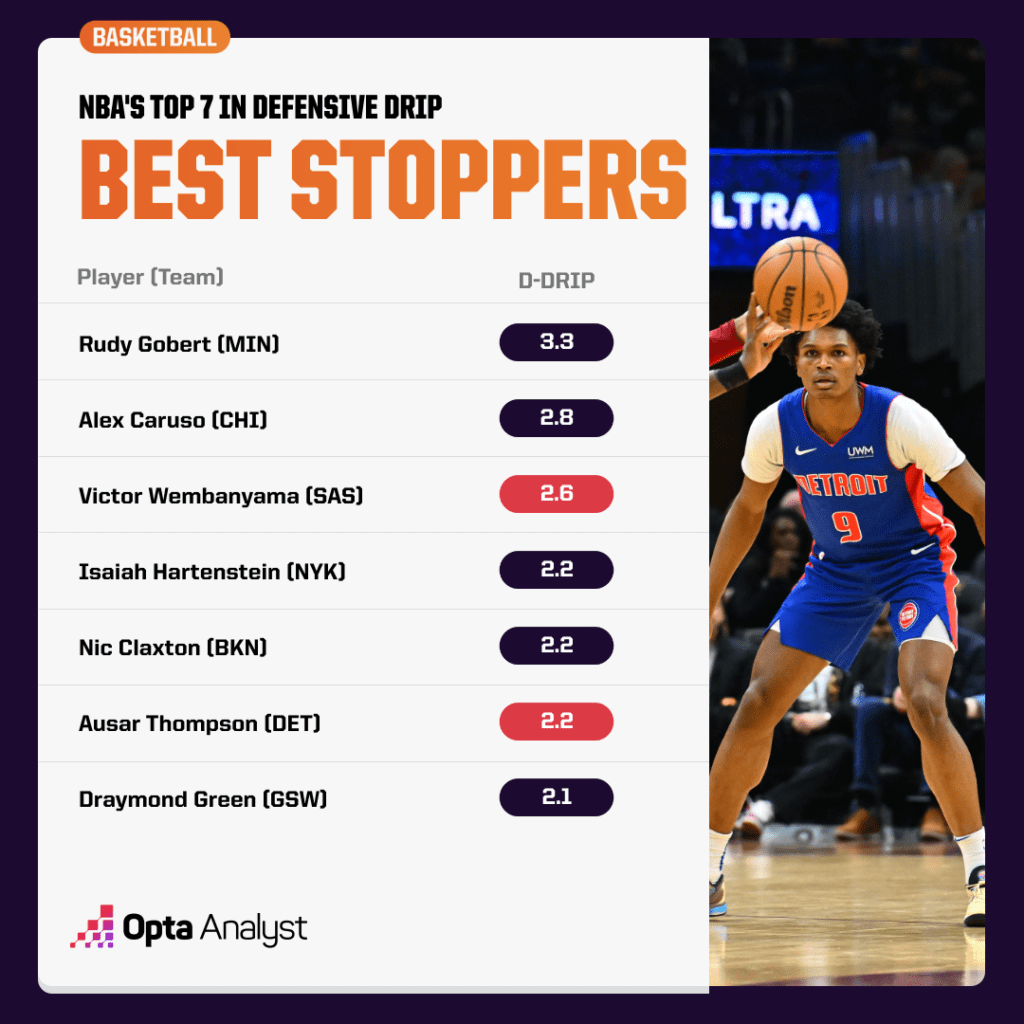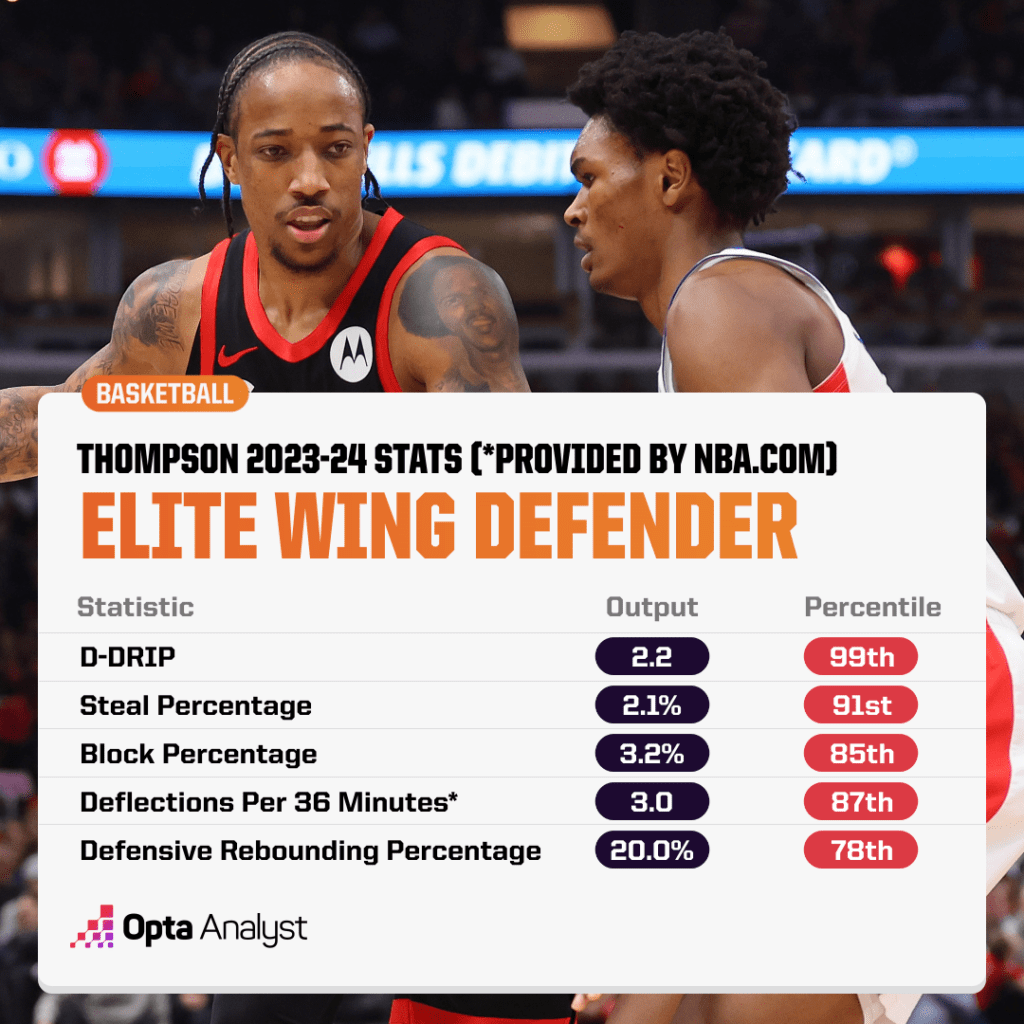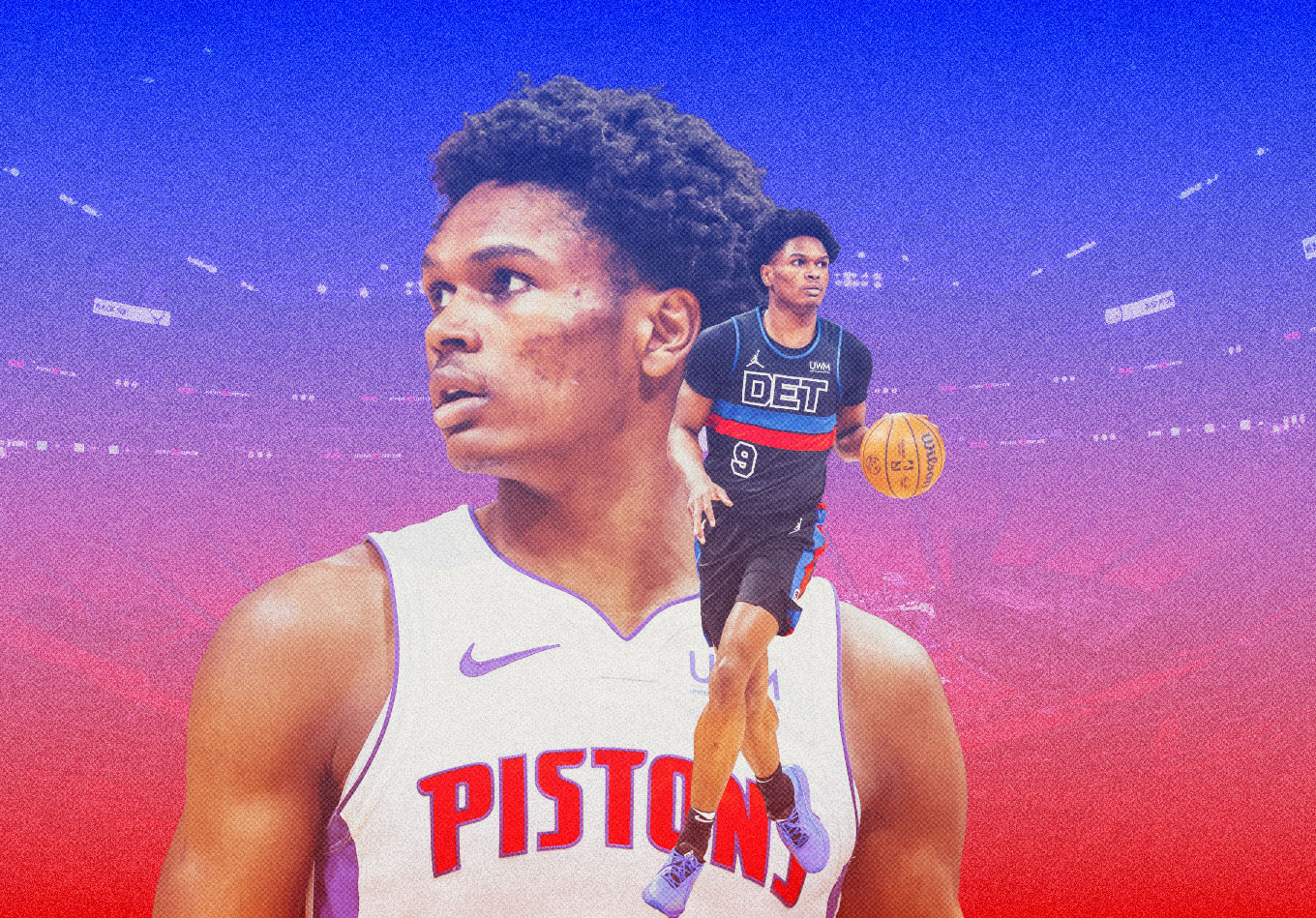If you take a gander at our DRIP leaderboard and sort by D-DRIP (our defensive one-number metric), you will see that there are not, one but two rookies in the NBA’s top six.
The first is none other than the venerable Victor Wembanyama (duh). But the other rookie sitting in the league’s upper echelon on defense may surprise you.
It’s not Chet Holmgren or Dereck Lively II. Heck, it’s not even Amen Thompson. Instead, it’s the other Thompson twin, Ausar.

Thompson may be only 61 games into his NBA career, yet he’s statistically already one of the best defenders in basketball. But what is it that makes him so good? What are his other strengths?
And how good can the Detroit Pistons’ Thompson twin become?
The Good
Thompson’s legend as a premier defensive wing went mainstream on Oct. 30 when he did battle with Shai Gilgeous-Alexander and the Oklahoma City Thunder.
Gilgeous-Alexander is having a phenomenal season (he’s currently third in MVP odds), but you wouldn’t know it by watching him trying to score on Thompson.
His defense against Gilgeous-Alexander, who had 32 points but matched his season high with five turnovers in the contest, is instructive because it illustrates all of Thompson’s strengths as an on-ball defender.
He’s light on his feet, which makes shuffling side-to-side and mirroring his opponent’s movements a walk in the park for him. It doesn’t take too much power for him to jump. So, even if he bites on a pump fake, Thompson has time to recover and get back in front of his man. And he’s got supreme length (6-foot-6 with a 7-0 wingspan), which lets him overwhelm shooters with his contests.
Thompson isn’t just a point-of-attack stopper like Dillon Brooks. Thompson can create positive off-ball outcomes for his team with his defensive playmaking.
The clips above also highlight more of Thompson’s tools. He’s got mind-bending reaction time, great hands (91st percentile steal rate), and a high motor (87th percentile in deflections per 36 minutes, per NBA.com).
That word, “tools,” is the key to Thompson’s incredible defensive start. Thompson is a freak athlete, even by NBA standards.
Normally, it takes rookies some time to adjust to the technical elements of NBA defense. As a result, most rookies are statistical negatives on that end of the floor. Thompson suffers from some of those growing pains (for instance, he is prone to occasional off-ball lapses). But his 99th-percentile athleticism enables him to overcome these pains and still excel.
(Sidebar No. 1: Speaking of the ease in which Thompson can leave his feet, the rookie is also a really strong weak side rim protector. He’s in the 85th percentile in block rate league wide, despite not being a center.)

On offense, Thompson is a non-shooting non-center (more on this in a moment). For those players, there is a template that needs to be followed to avoid crushing your team on offense. You need to be a good cutter, offensive rebounder, driver off the catch, and screener/roller.
Right now, Thompson is solid in all of those areas. He’s in the 45th percentile in efficiency on cuts (first clip in the montage below), the 87th percentile in offensive rebounding percentage (second clip), the 58th percentile in true shooting on drives (third), and the 52nd percentile in efficiency on rolls (fourth).
The Bad
Back to the part about Thompson’s shooting. To be frank, it’s bad. Thomspon is an 18.3% 3-point shooter, and his other shooting indicators aren’t any better.*
[*Sidebar No. 2: Thompson is in the fifth percentile in free-throw percentage (60.2) and the first percentile in wide-open 3-point percentage (16.0)].
The chances of Thompson turning into an average/above-average shooter/spacer are bleak. But there is one statistical thread that suggests that there may be some hope.
Thompson is shooting 44.8% from 10-16 feet and 41.0% on all midrange shots. This matters because we often see young players who start out as good midrange shooters develop into better 3-point shooters.
They have the touch to be good outside shooters, but they struggle early on from distance because they don’t have the requisite lower-body strength to successfully launch the ball from the NBA 3-point line at an efficient rate. Maybe this ends up happening to Thompson.*
[*Sidebar No. 3: I hand-tracked all 78 of Thompson’s missed non-heave 3s, and 40 of those 3s (51.2%) were missed because they were too short. This adds some credence to the argument that his poor 3-point shooting may be a result of Thompson’s sea legs not being under him yet.]
Outside of his shooting woes, Thompson’s two biggest concerns are 1) his handle (20th percentile in turnover percentage), which limits his drive game (and we’ve established how important that is to him), and 2) the fact that he’s not a center, which makes his defensive contributions less valuable and offensive struggles more damaging.
The Bottom Line
It feels like people are always more optimistic with this player archetype (the defense-first non-shooting wing/forward) than anyone else. Hey, they can’t shoot, but they are so good on defense that, if they just improve their jumper, they will be a real problem!
That is true. But it is also really hard to go from non-shooter to a shooter the defense has to take seriously. And as we saw last postseason with guys like Isaac Okoro and Jarred Vanderbilt, it can get really ugly on offense when that jumper doesn’t come around.
Thompson’s combination of insane reaction speed and physical tools is reminiscent of the great wing/forward defenders of the past, like Shawn Marion and Andrei Kirilenko. The question with him is not if he will be an All-Defensive Team player – but when it will happen.
If the leg strength theory is correct and Thompson turns into a great jump shooter, then he instantly becomes one of the best role players in basketball (which means he’d be a borderline top-50 player in the NBA).
But if that doesn’t happen, and Thompson continues to be an elite defender who can’t shoot, he’ll make for a good regular-season player. But if a player like that wants to be an integral part of a playoff roster, they’ll need to either play on a team with a ton of spacing, be a good tough shot-maker, or be very positionally big and physical.
The first of those circumstances is out of Thompson’s control (and honestly, really hard to find). As for tough shot-making, he isn’t exactly Jaime Jaquez Jr. in that department. So, that means Thompson will need to rely on size and physicality to stay afloat on offense – like Aaron Gordon did last year.
At this point in time, Thompson isn’t as muscular as Gordon. But he isn’t afraid of a fight, either. Thompson battles with brutes around the dunker spot and gets his hands dirty while bidding for difficult-to-acquire rebounds (he’s in the 68th percentile in contested rebounding percentage). And as we highlighted above, Thompson is doing well in all the offensive play types you need to succeed in to make the non-shooter thing work (like Gordon).
It’ll take some time for him to reach Gordon’s level, but there is a pathway toward Thompson playing a similar role for a title contender down the line.
In the perfect world, Thompson becomes a serviceable 3-point shooter and solidifies himself in the pantheon of all-time role players. But even if that doesn’t happen, Thompson still has the ability to be a very valuable player for a very good team.
Check out our MLB and NBA coverage, and our college basketball picks. Follow us on X and Instagram for more!
